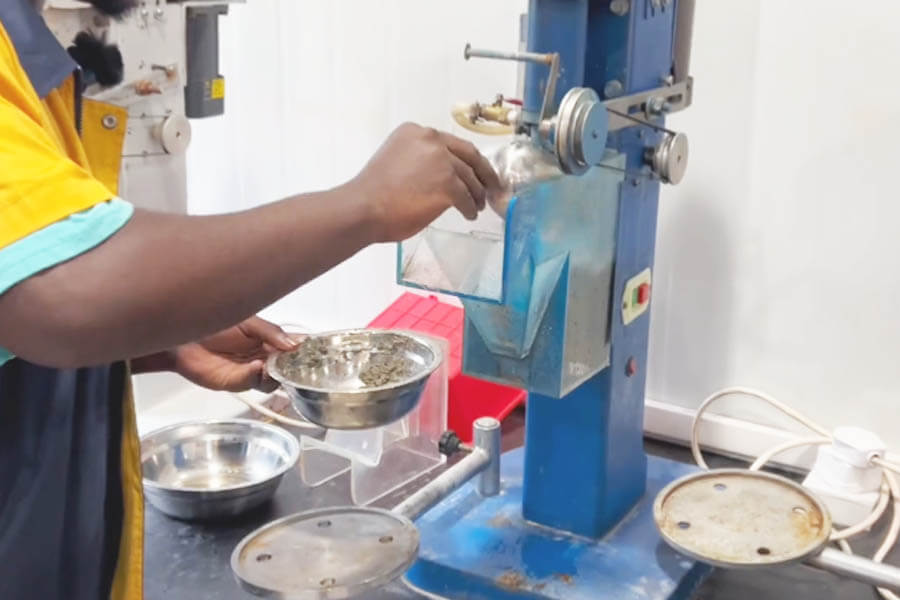Lead-zinc ore is one of the world’s most important metal mineral resources, with large reserves and wide distribution. Flotation has been widely used in lead-zinc ore beneficiation due to its high efficiency, low cost, and environmental friendliness. The laboratory lead-zinc ore flotation test procedure is key to determining whether the beneficiation process can achieve satisfactory results. It is vital in determining optimal process parameters and developing efficient flow diagrams for industrial-scale production. We will cover all laboratory mineral testing service stages, including sample preparation, mineralogy analysis, flotation, gravity and magnetic separation tests.
Lead-zinc Ore Sample Beneficiation Test Steps
Laboratory mineral beneficiation tests are performed on small-scale samples in a laboratory environment; after the process is defined, the customer proceeds to large-scale production. Lead and zinc are two of the most essential metals in various industries, including construction, transportation, and electronics. However, the beneficiation of lead-zinc ore is a complex process involving several stages of crushing, grinding, gravity separation, and flotation to produce high-quality concentrate. Therefore, it is essential to prepare ore samples for analysis and testing in the laboratory.
The following are the steps of the beneficiation test of the lead-zinc ore sample:
- Sample preparation: Obtain a representative 50kg lead-zinc ore sample (raw ore is about 100mm) for testing.
- Chemical analysis: Conduct a comprehensive chemical analysis of the lead-zinc ore samples to determine their elemental composition. This analysis helps to understand the grade and impurity levels of the lead-zinc ore.
- Mineralogical analysis: Mineralogical analysis is performed to determine the mineral composition present in the ore. This analysis helps to understand the lead-zinc composition of the ore, including the distribution of valuable or gangue minerals.
- Crushing and grinding:Determine the crushing and grinding characteristics of the ore to evaluate its grindability and release characteristics.
- Put 100mm raw ore into the jaw crusher. The crusher’s fixed jaw plate and movable jaw plate will work and crush the material to 10-40mm, and the crushed material will be discharged from the discharge port at the bottom of the jaw crusher.
- Then, the 10-40mm material is poured into the feed port of the double-roll crusher, and the crusher rollers will rotate and squeeze the crushed material to a specific particle size, such as 0-10mm, 0-5mm.
- Pour the material crushed by the double roller into the vibrating screen with the screen. As the equipment vibrates, larger materials will be screened from above, and smaller materials will fall below the screen and be sent together.
- Pour the material into the ball mill, the particle size of the material is generally 25mm. Through grinding with steel balls inside, the material can be ground into powder of 0-1mm or 0-200mesh as required.
5. Gravity Separation Test: Evaluate the potential of gravity separation technology for pre-concentration or recovery of lead and zinc minerals. The shaking table separates fine-grained materials and is the most commonly used gravity beneficiation equipment in beneficiation operations. It is used primarily to recover fine-grained minerals of 0-2mm. Put the 0-1mm lead-zinc slurry into the shaking table. The ore particles are separated according to density using mechanical shaking and water flushing. Multiple products can be obtained simultaneously, and the zoning of minerals on the bed surface is obvious.
6. Flotation test: Use a laboratory flotation machine to conduct batch flotation experiments under various conditions, such as pH value, reagent dosage, and flotation time. Measuring the recovery and grade of lead-zinc concentrates to optimize the flotation process. Pour the slurry into the tank and dilute it with water to the required concentration. Start the motor and add an appropriate flotation agent according to the experimental requirements. When there is foam in the tank, turn on the switch of the scraper part to start flotation. After the specified flotation time, the motor is turned off to stop the impeller and scraper from running.
Final gravity separation and flotation can be applied to the lead-zinc ore beneficiation. Our laboratory flotation machine is a standard sorting equipment that needs to be added with conventional chemicals. Different ore samples require different medicaments. The actual situation needs to be answered by our professional laboratory engineers.

The results obtained from the above tests provide valuable information on the behavior of the mineral during processing and help optimize recovery and product quality. We will provide design, management, and evaluation services for all phases of the entire project, from laboratory to factory trials. Our specialties include crushing and grinding, materials handling, mineral processing and hydrometallurgy. Our researchers can evaluate various gravity separation, flotation equipment designs and develop more efficient processes for extracting minerals from ore. Asia-Africa International laboratory test service has worked closely with industry and external partners to provide flexible solutions for experimental testing, process development, and sample production.
